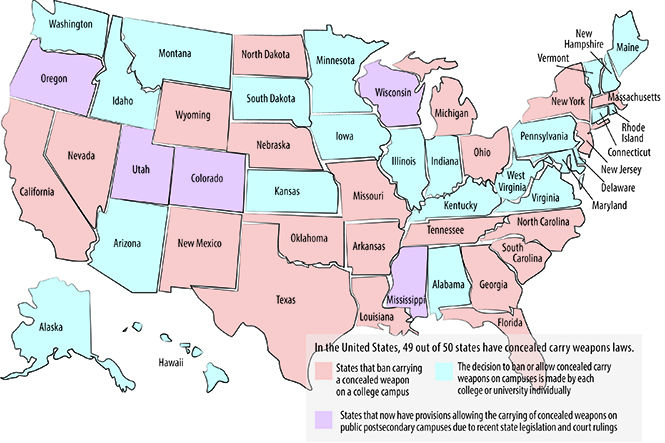Bill allowing concealed carry on campus faces opposition at KSU
October 2, 2012
Professor Erik Heidemann was teaching at another large state university last year when an incident with a manic-depressive student made him rethink his views regarding guns on college campuses.
“He waited for me until after class adjourned, and I was alone,” Heidemann said. “I was worried that all the rest of the students had [left], and I thought, ‘Is this where he pulls out a gun and blows me away?’”
Although the student, who was just concerned about his grade, ultimately did not intend to harm him, Heidemann said the moment of panic highlighted the possibility of a violent attack on campus. The former National Rifle Association member said guns “belong in a hunting field, not in public buildings.”
Now, a bill that would allow students to conceal carry weapons on campuses in Ohio is making an already flawed policy worse, said John Peach, Kent State police chief.
Peach said he disagrees with the current law — and the possible side effects of the pending bill — because it allows guns on campus grounds.
College campuses and concealed carry laws
Ohio is one of 21 states that ban carrying concealed weapons on college campuses, according to the National Conference of
State Legislatures (NCSL).
Twenty-four states allow each college or university to decide for themselves whether to allow concealed carry on campus.
Five states — Colorado, Utah, Wisconsin, Mississippi and Oregon — have provisions that allow concealed carry on campus.
Utah law specifically rules that its 10 public universities do not have the authority to ban weapons.
“We don’t like the fact that a person can come on campus and lock a gun in the trunk — cars are broken into and stolen,” he said. “We are very fortunate that campuses are still seen as an exclusion to the right to carry concealed weapons anywhere you want.”
Ohio gun laws currently prohibit concealed carry of a firearm on any college campus unless the handgun is locked in a motor vehicle trunk.
If passed, Ohio House Bill 256 would allow concealed carry permit holders to carry firearms at public or private colleges and universities. Sixteen states this year have introduced similar legislation, and all but two have failed.
State Rep. John Adams, the bill’s sole sponsor, said he couldn’t comment on the bill because it is still in committee, but an aide said Adams is “pro-Second Amendment on every level.” The bill, introduced last year, is waiting for approval from the State and Government Elections Committee.
Ohio Rep. Kathleen Clyde, representative of Kent State’s respective district, did not return multiple calls to her office. When the bill was first introduced, Clyde said she wasn’t sold on the idea of allowing weapons on a college campus and that she had “pretty serious concerns.”
Junior English major Jessy Pettit said she is considering getting a concealed carry permit, but she doesn’t think schools are an appropriate place for guns. If she did get the permit, she said she would only use it for self-defense and would not carry a gun on campus.
Adam Sladek, a junior teaching English as a second language major, said he does not think it is necessary to allow guns on campus because Kent State has its own security.
“I would not feel secure knowing some of these people were walking around with guns,” he said.
Because improving Kent State’s security is an ongoing task, Peach said the police department is always learning new strategies and techniques.
“We’re constantly looking at vulnerabilities on the Kent State campus — working with the city and the county emergency management — so that we can help coordinate and integrate emergency response,” he said.
The July tweet to “shoot up” Kent State by former student William Koberna has not resulted in any specific security updates. The threat was an “immature, emotional response — something we all see on a regular basis,” Peach said, adding that after a few hours of assessing Koberna, the department felt confident that he was not a threat to the university.
Peach said the biggest security change Kent State has made recently regards the response to a crisis situation. While the national standard is to approach the scene with three to four officers, he said, Kent State began training during the summer for a solo-entry approach, which instructs officers to face situations alone.
The solo-entry tactic is gaining acceptance and has received positive feedback throughout Ohio, Peach said.
“Common sense says by the time you get three or four officers there to meet the three or four threshold, you have a lot more victims,” Peach said. “So with the help of some of the officers we have in our department who are well-trained in terms of active shooters, we felt that we were in a position to start changing the trends.”
Contact Amanda Crumm at [email protected].

























